List of Authors
>>About this blog
Recent blog post
|
[Nojinya]
August 18, 2015 09:00
August is a season when there are many festivals nationwide, but there are many events in Chuo-ku, including Sumiyoshi Taisha Shrine Reitaisai festival, Tokyo Bay Fireworks Festival, and Tomioka Hachimanji Miya carrying of miniature shrines. I would like to see a blog post from my correspondent, and last Sunday, August 9th was National Day in Singapore. This year was  a memorable year of 50 years of independence from the Federal Republic of Malay, and it seems to be a fairly grand festival. In recent years, when the midsummer climate continues in Chuo-ku, I visited a Singapore restaurant in Hatchobori today to enjoy the ever-summer Singapore mood. a memorable year of 50 years of independence from the Federal Republic of Malay, and it seems to be a fairly grand festival. In recent years, when the midsummer climate continues in Chuo-ku, I visited a Singapore restaurant in Hatchobori today to enjoy the ever-summer Singapore mood.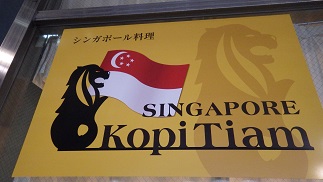
The name of the shop is "Kopi Tiam", which is often heard in Singapore. It means a "coffee shop" with Tiam (store; Fujian) attached to the Malay word Kopi (coffee), and it is an image of a coffee shop or snack shop that offers snacks in addition to drinks such as coffee.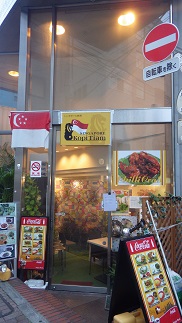
When you open the automatic door of the shop along Suzuran Street and enter, there is a space where about 20 people can sit under the fluorescent light. 。 。 It's already full of Southeast Asian mood. There are black and white photographs of old Singapore on the wall, which further enhances the atmosphere.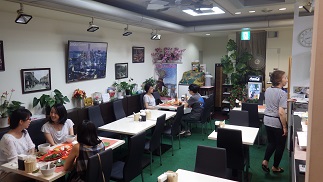
We arrive at a white table that we don't care about, and first we will have a classic "Tiger Beer ". I'd like to drink on the jokki and on the rocks like the Hawker Center (outdoor food court) in Singapore, but today I'm polite to have a glass straight. ". I'd like to drink on the jokki and on the rocks like the Hawker Center (outdoor food court) in Singapore, but today I'm polite to have a glass straight.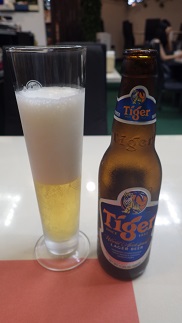
The restaurant recommends the typical Singapore cuisine "Hainan Chicken Rice", "Nashigoren (Indonesia-style stir-fried rice)," meat bone tea (bakute), "South India-style curry" and the Hawker Center in Singapore. That should be the case, and his husband, Mrs. and Mrs. A, lived in Singapore 30 years ago, so they seem to know the local taste. Even after returning to Japan, the shop was opened in Tokyo as a place where you can enjoy authentic Singapore cuisine, and the taste of Singaporeans living in Tokyo also goes to the shop with origami.
I decided to have "meat bone tea" tonight. If you're not familiar with Singaporean cuisine, hear it's meat bone tea. ? ? I think so please give me a mini commentary here. 。 。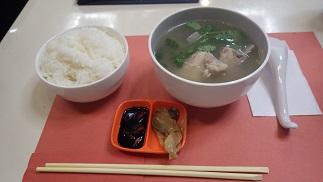
It contains the word "tea", but as you can see, it is a medicinal soup that contains pork with bone, not tea. It seems to originate from the cuisine of Fujian, the hometown of bitterness (Kouri; migrant workers from China) during the colonial period of British territory. There is only a dish developed as a meal for port workers on the Malay Peninsula, which has a severe climate, and plenty of meat contains garlic, cinnamon, pepper, pacchi and other spices, and it is full of nutrients and energy. I'm going to survive this heat. Next time, by all means, I would like to try "South India-style curry" recommended on the way home. My husband says it's quite painful, but I'm looking forward to it now.
【Singapore Kopi TIam】
〒104-0032 2-18-5, Hacchobori, Chuo-ku, Tokyo
TEL: 03-6280-3442
Business hours 1800-2200 (Lunch is also open and closed on weekends and holidays)
[I want to see]
August 13, 2015 18:00
In my father's days, sake was called "special sake, first-class sake, second-class sake", but it was called "special sake, first-class sake". was called "special sake, first-class sake, second-class sake", but it was called "special sake, first-class sake".
In the Heisei era, they have finally become memories of the past.
Nowadays, there are various kinds of sake, and I'm wondering what to choose.
honjozo, Ginjo, daiginjo, special, pure rice, etc.
It's good news for those who think daiginjo looks delicious, but the price is ...
Why don't you go to Kochi antenna shop "Marugoto Kochi"?
Take Exit 3 of Ginza 1-chome Station on the Tokyo Metro Yurakucho Line and head toward the expressway. and head toward the expressway.
"RYOMA-san" welcomes you at the corner.
When you go down the basement, you will find sake!
"What shall I do?"
Some of them are Daiginjo sake from Mr. Kuramoto, a family-run company, and they seem to be gentle on your wallet.
And most of all, the most enjoyable thing is the tasteta-Im
You can taste "Select Beauty Sake" of the shop.
A cup of 200 yenya from 12:00 noon to 19:00 at night (18:00 on Saturday)
There are also 3 cups plus tidbits (Today's tidbits) 650 yenya.
Of course, if you like it, you can buy that liquor and tidbits in the store.
Listen to the shop, talk with the tasters, and talk with each other.
I feel like a little drinking party.
A little bit of a bit of a bit of a bit of a bit of a bit of a bit of a bit of a bit of a bit of a bit of a bit of a bit of a bit of a way home from a business trip, a bit of a bit of a bit of a bit of a bit of a bit of a bit of a bit of a bit of a bit of a bit of a bit of a way home from shopping.
Oh~~~~~~
It's a fun place.
[Nojinya]
August 12, 2015 14:00
Last time, we introduced an antenna shop in Chuo-ku as "Heisei no Kurayashiki in Chuo-ku-Part 1-" (/archive/2015/08/-in-3.html).
After the unification of the world by Nobunaga and Hideyoshi, rice and product transactions began to be active throughout the country. It started with the construction of an office and warehouse (= Kurayashiki) as part of the clan residence in Edo, where the shogunate is located.
This time, we will take up regional banks ("local banks"), which are regional financial institutions that represent the region, as Heisei's Kurayashiki-Part 2. The Tokyo branch of the regional bank supports the expansion of local companies in Tokyo, and it can be said that it is a modern version of warehouse that is often found in Chuo-ku, the center of Tokyo.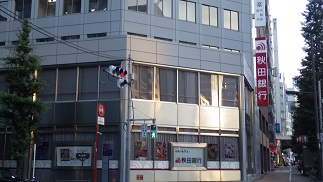
[Akita Bank (Kyobashi / Kajihata-dori)]
By the way, the number of regional banks throughout Japan (the first regional bank that is a member of the National Regional Bank Association) is 64, but although the exact number is unknown, nearly 90% of them are probably Nihonbashi, Kyobashi and Yaesu. It seems that they have a Tokyo branch in Chuo-ku. This is, of course, closely related to the Bank of Japan. 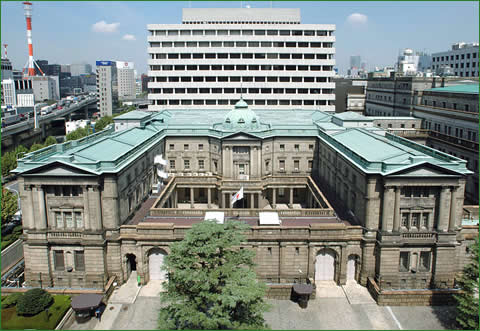 Bank of Japan (Honishi-cho) Bank of Japan (Honishi-cho)
Just as the daimyo set up a clan residence as a contact point with the Shogunate along with the purpose of residence of the family in Edo, the regional banks also set up services to business partners in Tokyo and receive supervision (examination) from the Bank of Japan. It seems that it was placed in Chuo-ku, the knee of the Bank of Japan.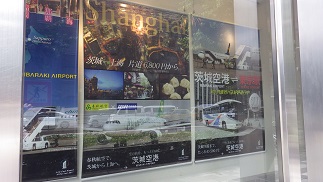
[Joyo Bank Show Window (Yaesu / Kajibashi Crossing])
Since it is the Tokyo branch of such a solid regional bank, there are many show windows that are relatively plain, such as introducing local specialties and famous places, but overturning such images at Hatchobori 2-chome intersection where Yaesu Street and Heisei Street intersect. Tokyo branch of a certain regional bank.
"OKB3 birth " 。 。 There is a flashy poster of a beautiful sister three, and I'm a little surprised! It's " 。 。 There is a flashy poster of a beautiful sister three, and I'm a little surprised! It's  a launch like a Ginza club rather than a local bank a launch like a Ginza club rather than a local bank  with a solid image. with a solid image.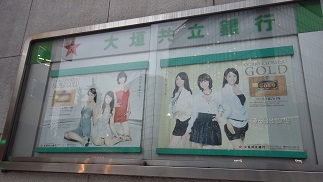
AKB's non-OKB is an acronym for Ogaki (Ogaki) Kyoritsu (Kyoritsu) Bank (Bank), an idol unit certified by Yasushi Akimoto, which was formed by recruiting members from female employees on their own. . In addition, OKB45 (45 people) has been added to OKB3, and it seems to be OKB48 in total. This is a remarkable bank PR, and OKB45 is also attracting events such as shopping streets around Gifu Prefecture. It seems that Ogaki Kyoritsu Bank is famous as an attacking bank in the industry, but according to a friend living in Gifu, Ogaki is a general store called "OKB Ranch" that is not an OK ranch (the naming is soft, but the Ogaki Kyoritsu Bank established It seems to be a regional bank with a fairly innovative culture. Thanks to such efforts, this bank ranked fourth in the Nikkei Financial Institution Ranking Survey (January 2015), which competes with high customer satisfaction, pushing megabanks and foreign banks.
[Toho Bank (Kyobashi / Chuo-dori)]
Enjoyment unique to Chuo-ku, where regional banks accumulate. Since it is a bank, you can't easily enter the store like an antenna shop, but if you find a colorful signboard in the city, why not look at the show window a little? There may be a new discovery.
[TAKK...]
August 10, 2015 18:00
On Saturday, August 8, 2015, the Tokyo Bay Fireworks Festival was held.
Approximately 12,000 fireworks colored summer nights in the Gulf region.
・
This time, it can be viewed at the main venue of Harumi, and we started moving to the venue in the evening.
The means of transportation......Of course, it's Edo bus.
Near the venue, the road is blocked, there are many security guards, and it is already a vicious atmosphere.
.

.
Arrived at the venue.
Because the sun is high, I still have room for seats.
/

・
There is a slight scent of the sea (may be because of your mind)...... If you drink beer and wait while being blown by the wind, the sun will set in no time. If you drink beer and wait while being blown by the wind, the sun will set in no time.
`In fact, it was quite a long time......。)
・

・

・
18:50。
After the countdown, the launch began.
・

・

・

・

・

・

・

・
The Grand Finale is a masterpiece, fireworks spread throughout the night sky, and the visibility is filled with dazzling light.
・

・

・
That power is not something that can be expressed in a very small photo.
(At least, it's impossible with the arm of my photo .) .)
/
Finally, from "Chuo-ku Monoshiri Encyclopedia", I will quote a sentence written about fireworks.
"The excitement of fireworks that have been handed down over time has not changed at all times."
・
[Nojinya]
August 10, 2015 09:00
This is the end of today's work. I still have time until the evening banquet. 。 。 When I walked to Ginza while thinking that it would be thirsty when it was so hot, I found a nice standing drink BAR. It is a shop under the expressway where Sotobori-dori St. and Tokyo Kosoku Doro intersect.  As I mentioned in my blog post before, it is a place equivalent to "Bikunihashi" depicted in Hiroshige Utagawa's "Hundred Views of Edo, Bikunihashi Snow" (/archive / 2014/04/post-1949.html). Tokyo Kosoku Doro is made by reclaiming the old Kyobashi River, so it means that the river was flowing here until 55 years ago. As I mentioned in my blog post before, it is a place equivalent to "Bikunihashi" depicted in Hiroshige Utagawa's "Hundred Views of Edo, Bikunihashi Snow" (/archive / 2014/04/post-1949.html). Tokyo Kosoku Doro is made by reclaiming the old Kyobashi River, so it means that the river was flowing here until 55 years ago.
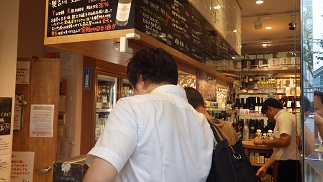
When you enter the store, there is a small table near the counter and window, where you can enjoy a little drink while 1 sho and 4 go bottles are lined up narrowly. In addition to enjoying the recommended sake and knobs of the shop, those who are home parties can buy sake here and go home. Originally, it is a standing drinker run by a liquor store in Yokohama called Kimishimaya, and there are plenty of varieties such as shochu and wine as well as sake. I received Chigasaki liquor called Tensei, which was recommended by the shop, and it was cold and very delicious!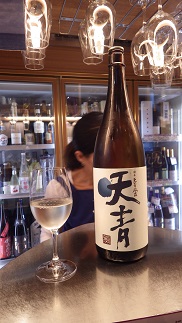
By the way, this Kimishimaya was founded in 1892. It opened in Tokyo in 2006 (Marunouchi store) and reopened as this Ginza store in 2013. There is also a wine cellar in the back of the store, filled with wine directly imported from production areas such as France, Italy, Spain and the United States.
In this season when the sun is long, how about a cup while looking at the office town in Marunouchi in the evening?
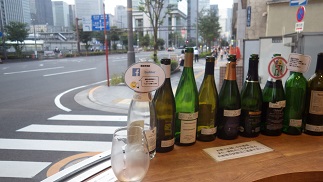
[Ginza Kimishimaya]
〒104-0061 Konya Building 1F, 2-1 Ginza 1-chome, Chuo-ku, Tokyo
TEL: 03-5159-6880
Business hours 1030-2100 (until 2000 on Saturday and 1900 on Sunday)
[Old Rose]
August 9, 2015 18:00
Last Saturday, before attending a lecture at the Tsukiji Reservation Study Group starting at 2:00 pm
We had a break at Akatsuki Park. at Akatsuki Park.
Then there was a sweet scent like "Pu-n". a sweet scent like "Pu-n".
When I approached the scented side, there was a large fig tree. a large fig tree.
It was still blue, but it had a lot of fruit.
Sitting on the bench in the park and starting to drink tea
I just heard the bell of lunch, and I heard the bell of a rhythm that I rarely heard. lunch, and I heard the bell of a rhythm that I rarely heard.
Is it a kind of hymn?
By the way, this Tsukiji Reservation Study Group is "The Founding Story of Kyobunkan".
Surprisingly, the original author of "Hanako and Ann" as a special guest
Eri Muraoka's sisters were participating.
I have been participating in this meeting for the second time.
There is a surprise every time, and I like the atmosphere that I couldn't taste at this meeting.
[NPO Tsukiji Reservation Study Group] http://www.tsukiji-kyoryuchi.com/
|
Links
|
![]() a memorable year of 50 years of independence from the Federal Republic of Malay, and it seems to be a fairly grand festival. In recent years, when the midsummer climate continues in Chuo-ku, I visited a Singapore restaurant in Hatchobori today to enjoy the ever-summer Singapore mood.
a memorable year of 50 years of independence from the Federal Republic of Malay, and it seems to be a fairly grand festival. In recent years, when the midsummer climate continues in Chuo-ku, I visited a Singapore restaurant in Hatchobori today to enjoy the ever-summer Singapore mood.


![]() ". I'd like to drink on the jokki and on the rocks like the Hawker Center (outdoor food court) in Singapore, but today I'm polite to have a glass straight.
". I'd like to drink on the jokki and on the rocks like the Hawker Center (outdoor food court) in Singapore, but today I'm polite to have a glass straight.


 Bank of Japan (Honishi-cho)
Bank of Japan (Honishi-cho)















 As I mentioned in my blog post before, it is a place equivalent to "Bikunihashi" depicted in Hiroshige Utagawa's "Hundred Views of Edo, Bikunihashi Snow" (
As I mentioned in my blog post before, it is a place equivalent to "Bikunihashi" depicted in Hiroshige Utagawa's "Hundred Views of Edo, Bikunihashi Snow" (



